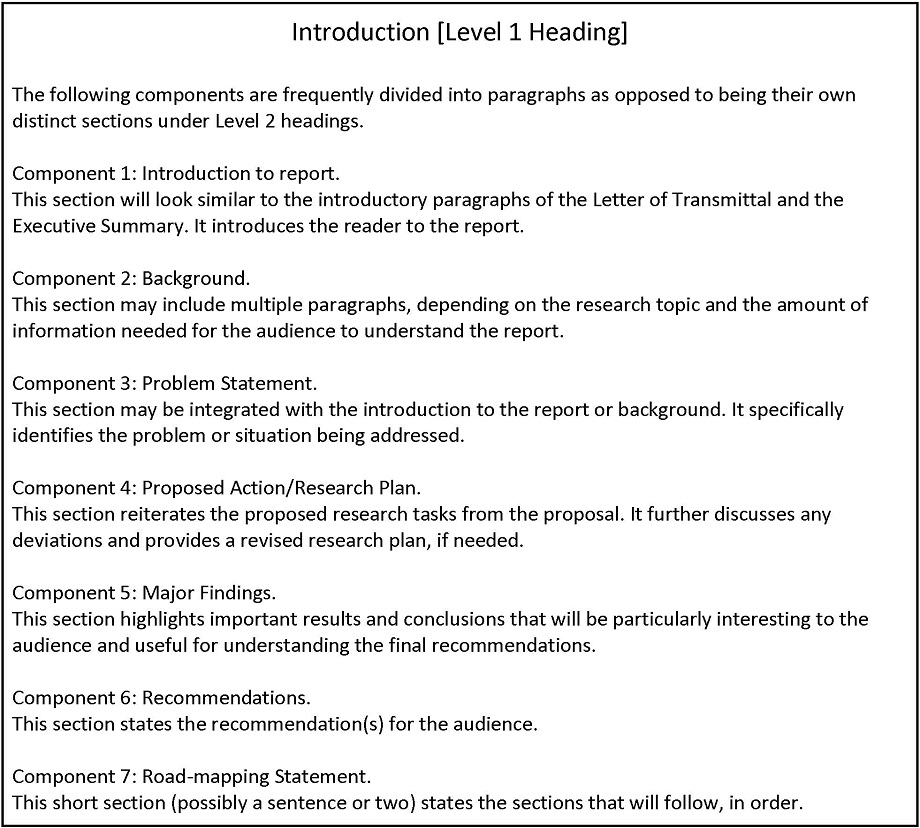20 – Recommendation Reports
Introduction
David McMurrey; Annemarie Hamlin; Chris Rubio; Michele DeSilva; and Matt McKinney
The body of the report includes the main text of the report (that is, the sections ranging from the introduction to the conclusion). Different types of reports contain different sections depending on their purpose and audience needs.
An essential element of any report is its introduction, the section where you clearly state your report’s purpose and contents. In a technical report, the introduction prepares the reader to read the report’s main body.
Keep in mind that while this section’s function is similar to the front matter, the introduction’s purpose is a bit different. Instead of providing a brief but comprehensive overview of subsequent sections, the introduction covers essential information about the issue or topic in more thorough detail, including what the reader needs to know about the issue to understand its seriousness and your motivation to research it.
One organizational strategy that can work well for introductions is John M. Swales’ CARS (Create A Research Space) Moves,[1] which consists of three steps:
- Establishing a territory. This is where the writer discusses general facts about the topic or recent developments surrounding it. For example, if your research is investigating the effects of a new policy on a business’s productivity, this is where you would describe the policy and what it entails in a neutral manner. If you are conducting medical research, this is where you might discuss recent developments in the field.
- Establishing a niche. Also referred to as “finding the gap,” having provided a neutral overview of important or recent facts on the topic, the writer then moves into a more specific gap in the overview. In other words, you are moving from what people are saying about your issue to what has not been said, and why this niche is important. In the business internal research report, this might be an unintended consequence of the new policy. In the medical research report, this could be a variable that contemporary studies have not addressed.
- Occupying the niche. In this final step, the writer explains the focus of their research and frames it in response to the niche outlined in Step 2. Since the reader at this point has a basic understanding of what information the writer finds important and how the writer understands the problem, this move can be made relatively quickly. In the business internal research report, Step 3 might entail the writer explaining how they are going to investigate the problem in the policy or even test the feasibility of a new one. In the medical research report, Step 3 might be the writer’s research question, stated hypothesis, and goal in conducting their study.
Swales’ CARS Moves is not the only way to structure the introduction, but it is a helpful strategy for scaffolding this section’s function in the report. It also helps the writer to create a smooth transition into the methods section, where the focus shifts from what your study is investigating or responding to, to how this investigation or response will be carried out. Figure 20.7[2] below provides a template for an introduction.

This text was derived from
Gross, Allison, Annemarie Hamlin, Billy Merck, Chris Rubio, Jodi Naas, Megan Savage, and Michele DeSilva. Technical Writing. Open Oregon Educational Materials, n.d. https://openoregon.pressbooks.pub/technicalwriting/. Licensed under a Creative Commons Attribution-NonCommercial-ShareAlike 4.0 International License.
McMurrey, David. Online Technical Writing. n.d. https://www.prismnet.com/~hcexres/textbook/. Licensed under a Creative Commons Attribution 4.0 International License.
- John M. Swales, Genre Analysis: English in Academic and Research Settings (Cambridge: Cambridge University Press, 1990), 141. ↵
- Nicole Hagstrom-Schmidt, “Introduction to a Recommendation Report Template,” 2021. Licensed under a Creative Commons Attribution-NonCommercial-ShareAlike 4.0 International License. ↵

